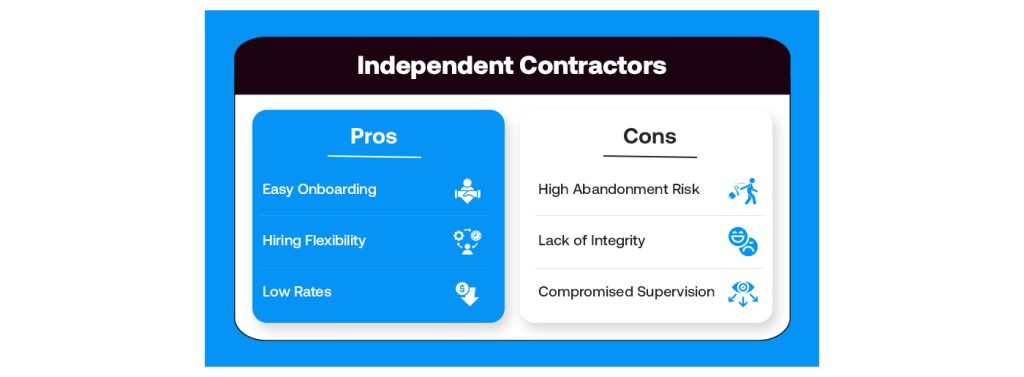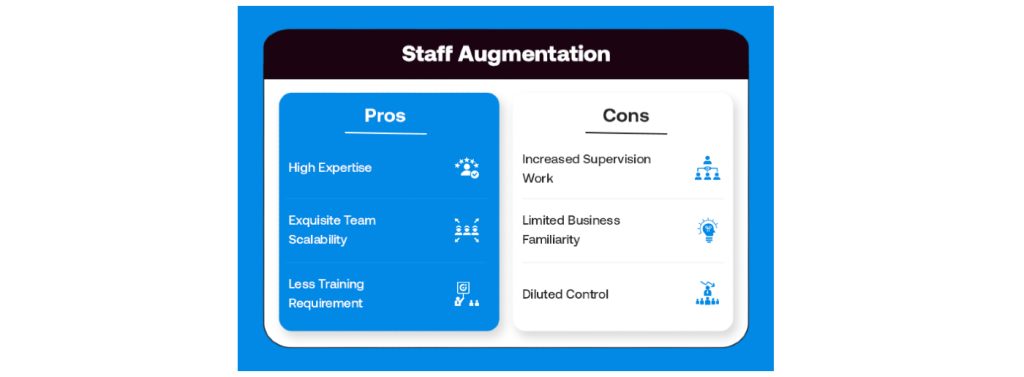Hiring Strategy for IT Outsourcing: Which Approach to Choose in 2023?
You have devised a great tech idea and are all set to execute it. All that is left now is to hire a team to work on the project. Well, how do you hire a team in the first place? Let us tell you that there are numerous ways to do so. If we were to categorize these ways, we could say that the two primary approaches are IT outsourcing and hiring an in-house development team.
Further, IT outsourcing can be subclassified into hiring an independent contractor and augmenting tech staff from a development outsourcing agency. All this information can be a bit tricky for businesses to understand. However, it is essential to know each option’s nits and grits to determine which is the right choice for your project. In this blog, we have thoroughly discussed these approaches for your easy understanding. By the end of the blog, you can decide which hiring strategies are ideal for your IT project.
Let’s start the blog with the basics, i.e., by discussing the importance of choosing the right hiring strategies in detail.
Hiring Strategies and Business Success: What’s the Fuss About?
In lay terms, a hiring strategy is an approach, methodology, or plan a business adapts to get a particular task done. As we mentioned earlier, the market has numerous hiring strategies to choose from.
Each strategy is unique in terms of its advantages and limitations, and therefore, there is no one solution here that fits all requirements. To elaborate, a hiring strategy ideal for business A might not be suitable for business B. This is determined by various factors, such as:
- The project’s size and complexity
- Business’s requirements
- Capital availability
- Communication requirements, etc
Therefore, as a business, you must be aware of all the different options available in the market to make the right choice. Moving further, we will individually discuss each IT hiring strategy in detail to find out which of them is the best option in which case. The first hiring approach we will look into is independent contractors.
Independent Contractor

Also known as freelancers, independent contractors are not associated with any organization or business and work in a nuclear setting. Today, separate contracts hold a 15% share of the employee market. Regarding IT projects, Independent contractors can be freelance developers specializing in one or more technologies, tech stacks, etc.
Generally speaking, most independent contractors charge on an hourly basis for the services they are offering. These charges usually vary with the technology they have expertise in, their experience, the region where they are located, etc. Let’s examine the pros and cons of hiring independent contractors for your IT project.
Pros
1. Easy Onboarding
Many businesses suffer from missed project deadlines and extended timelines because of various crucial yet unproductive activities that come with hiring an employee. One such activity is onboarding, where employees undergo induction and orientation before working on the project. Businesses that hire independent contractors gain the upper hand in this matter. This is because a business hiring freelance developers is not responsible for conducting any onboarding, induction, or training activities.
Resulting from this, hired independent contractors can immediately start working on the project as soon as they are finalized for the deal. This directly nurtures speedy development and ensures time-bound product delivery.
2. Hiring Flexibility
Flexibility in teams is an essential factor for businesses, especially regarding IT requirements. It is through flexibility that a company can ensure optimal quality and requirement-focused development for its project. Hiring freelance developers is ideal and enables businesses to practice out-and-out flexibility.
Simply put, you can fire a remote developer as quickly as you can hire one. Resulting from this, if at any point you find the hired independent contractor to be unfit for your requirements, you can fire them and hire a new one. Businesses often do this when the hired developer is not delivering the desired results.
3. Low Rates
As the global IT sector is booming, software development rates are skyrocketing. This factor limits the possibility of digitalization to certain businesses with adequate capital availability. However, this does not have to be the case in all scenarios, thanks to independent contractors.
It is a commonly known fact that hiring independent contractors is one of the most cost-efficient approaches to IT product development. Speaking in numbers, freelance software developers can charge as low as 15/hr, or even less, depending on their location. This way, you can significantly reduce the overall cost of your project by simply choosing to hire independent contractors.
Cons
1. High Abandonment Risk
We discussed earlier how businesses that hire independent contractors benefit from the exquisite flexibility that this hiring approach offers. Let us tell you that this is a two-way road, and separate contracts are as flexible as businesses while working on projects. In simple words, there are many cases where the hired independent contractors abandon the project amid the development process. This can be due to various factors, such as the hired developer finding another project with better pay, work boredom, personal conflicts, etc.
Because of this, businesses have no choice but to start the project all over again or find a developer willing to work on an incomplete project. Either way, the business suffers from an extended development timeline and compromised code quality.
2. Lack of Integrity
Integrity and honesty are critical values that businesses expect from their team. This is especially the case among companies dealing with unique ideas. However, it is a commonly known fact that this freelance development often comes at the cost of limited integrity and honesty.
Usually, many freelance developers resort to malpractices like reusing old codebases, selling ideas to other businesses, reselling a project’s codebase to another client, etc. These factors can, by large, be detrimental to your company and can result in tremendous losses.
3. Compromised Supervision
Businesses supervise their employees throughout the projects for optimal delivery and efficient development. However, it is always a challenge for businesses to oversee the work of independent contractors. Since most freelance developers work remotely, there is no accountability for their work to the outsourcer business. Moreover, it is always difficult to coordinate the project between the team of hired freelance developers as, in many cases, companies hire developers from different countries and, therefore, different time zones.
All of this directly compromises the final quality of the output and creates hurdles in the development process. This is usually not the case with other approaches, where supervision is seamless. That’s it for the pros and cons of hiring independent contractors for your project. Let’s move further with the blog and look at the second hiring strategy, staff augmentation.
Staff Augmentation

Staff augmentation is another outsourcing approach where businesses hire additional staff from an external agency based on their current business requirements and staff limitations.
Regarding IT projects, tech businesses can follow this hiring strategy to hire dedicated developers to work on their projects. The hired developers work as an extension of the current workforce temporarily. More than often, the developers working on this project work with an on-site development model. Let’s examine the pros and cons of IT staff augmentation.
Pros
1. High Expertise
In today’s world, creating a competitive product capable of standing out in the market is essential. Of course, this requires hiring developers with the best-in-class experience and world-class expertise in the technology they specialize in. When you augment your staffing requirements through a development agency, e.g., Latam Nearshoring, you will get the best and most experienced talent. Most development agencies focus on building long-term partnerships and recruit and deploy only the best talent. We recommend you
You can easily leverage this exquisite expertise of the augmented IT staff and build a world-class digital product with a competitive edge.
2. Exquisite Team Scalability
The entire concept of staff augmentation focuses on enabling businesses to hire additional human resources to meet the limitations of the present ones. In this aspect, you can hire more developers through this approach and quickly scale your team. To explain, staff augmentation gives businesses control to easily add or remove developers from the supplementary team as per their demand. This factor enables enterprises to utilize their human resources and optimize capital investment efficiently.
Moreover, a business can also change the developers working on the project as per its changing requirements and satisfaction with the developer’s services and output.
3. Less Training Requirements
Many times, businesses invest a lot of time and resources in training their employees. This often results in delayed timelines. However, a business can quickly reduce the requirement to train its employees by augmenting its staffing needs. Speaking factually, most companies increase their staffing requirements to overcome the limitations of their existing workforce. You can choose from many developers such agencies offer and select the one with the best-fitting skills and expertise.
Additionally, since most agencies deploy their most skilled and talented staff, you will not need to provide any training. This way, the selected developers can immediately kickstart your project’s development.
Cons
1. Increased Supervision Work
Employee supervision forms an integral part of project management. The better care you provide to your employees, the better output they will deliver. However, providing adequate control can be challenging among businesses with enormous team sizes. This is usually the case when companies augment their staffing requirements.
In case you choose to hire an on-site team through the staff augmentation strategy, there is no doubt that you will have more employees to supervise and take care of. Naturally, you will invest more time managing the expanded workforce instead of focusing on core business activities like strategic planning and business management.
2. Limited Business Familiarity
All employees must be familiar with the core values and missions of the organization they are working with. Additionally, in many cases, the developers working on the project must also be aware of the projects that a business has previously worked on to understand the quality and standards that the brand strives for.
Achieving this objective is highly difficult with staff augmentation. Since the new staff is hired only temporarily, it is impractical for the business to train each and every employee on its values, projects, and standards. Moreover, as you rotate the staff, you will have to provide this training repeatedly to achieve similar results from the developers.
3. Diluted Control
Businesses practice control over the hired employees in various aspects. This usually includes control over leave policies, notice periods, employment dissolution terms, performance appraisal, etc. However, this control can only be practiced over one’s employees and not the augmented staff. This is because, in most cases, the development partner practices such control over the increased staff and not the outsourcer business. This dilution of power can often result in reduced productivity from the hired developers and limited accountability, significantly impacting the development process.
These were a few pros and cons of staff augmentation. Next is in-house staffing, the third and last hiring strategy in this blog.
Hiring an In-house Team

As the name suggests, this hiring strategy focuses on recruiting a complete team of employees for your company to work on your requirements. Regarding IT projects, this means hiring an entire team of specialists in every stage of the development process, like business analysts, UI/UX designers, programmers, QA engineers, etc. Large-scale businesses commonly adopt this approach. Let’s examine the pros and cons of hiring an in-house development team.
Pros
1. Easy Communication
Developing a digital product requires out-and-out communication with the development team working on the project. This often involves communicating feedback, project changes, ideas, etc. Achieving this objective is easy with in-house developers. This is because most in-house developers are available in an office’s premises during work hours unless working with the off-site model. Moreover, since the in-house developers are often aware of the company’s standard operating procedures, coordinating project specifications with them is a hurdle-free process at most times.
2. High Trust
Employee trust and confidentiality are essential when recruiting a team to work on your project. The more trustable the employees are, the better collaboration will be between them and the management. The in-house employees have the upper hand in this aspect and benefit from tremendous trust. Since, in this approach, the employees are hired through a fair hiring process and are working in the company’s premises on the company’s terms, it is easy for the management to trust the employees.
Additionally, these in-house employees hold high accountability and answerability for their work, resulting in increased trust compared to the other two approaches.
3. Value for Investment
When a company hires an employee as a part of its in-house talent, it invests additionally in polishing the employee’s skills by giving them ample exposure and hands-on experience. A business needs to ensure that it gains optimally from such investments.
In-house employees often prove to be worthwhile in this aspect. Most in-house employees stay in a single company for up to many years, giving back for the value the business has invested in them. This factor nurtures mutually beneficial collaboration between the employer and the employee and sustains a healthy work environment.
Cons
1. Cost-intensive
Hiring an in-house team means that you, as an employer, are responsible for providing adequate infrastructure and facilities to the hired employees. The better infrastructure and facilities you can provide the hired developers, the better results they will deliver. However, this can often place a business under a tremendous financial burden. Simply put, providing adequate infrastructure and facilities to an entire team of developers is not easy and requires companies to spend additionally on such facilities.
Additionally, these facilities are not only limited to providing employees with an excellent workplace setting but also include recreational activities. The final figure can be astonishingly high for most businesses, making the entire project unfeasible.
2. Team Rigidity
Hiring an employee is a time taking process. In this scenario, if a business is building an entire team by hiring in-house employees, it is commonly understood that the company wants to retain its employees and reduce employee turnover. A few ways to do so is to bind the employment for a certain period, which most companies follow. However, doing so adds great rigidity and makes it almost impossible for a business to scale the created team.
Therefore, if you find out that the hired developer is not providing adequate performance, you must go to great lengths to take corrective measures or eliminate the developer from the team.
3. High Training Requirements
When a business hires an in-house team to work on its requirements, it also becomes responsible for providing adequate employee training. This training is integral to the employee’s career development and helps them leverage their skills.
However, doing so will mean your employees must take time out of their daily schedules and attend training sessions. Moreover, you will also have to invest additionally in establishing a learning and development department, based on the type and extent of training you will provide to the employees. All these factors can extend the project’s timeline and become unfeasible for many businesses, proving to be a significant limitation of the in-house development strategy.
These were the pros and cons of hiring an in-house development team for your project. We hope that by now, you are clear on which approach is ideal for you based on your business’s objectives and goals.
Summing It Up
To efficiently leverage technology, using the right and best available resources is essential. This includes choosing the right development team to work on the project. In this blog, we discussed three core hiring strategies businesses can choose from when hiring a developer for their project. We hope that by now, you know which approach to choose- an independent contractor, staff augmentation, or in-house development team. All you need to do is select the method you believe is ideal for you and conduct a well-planned hiring process for your project.



Leave a Reply